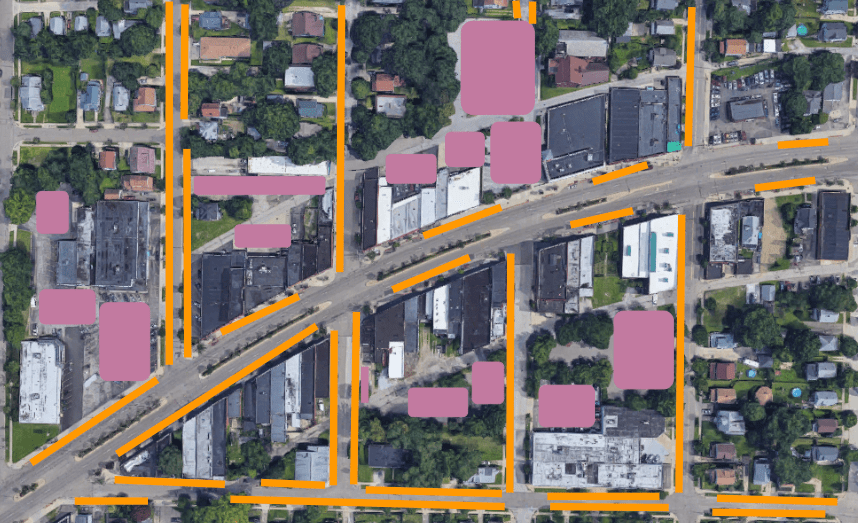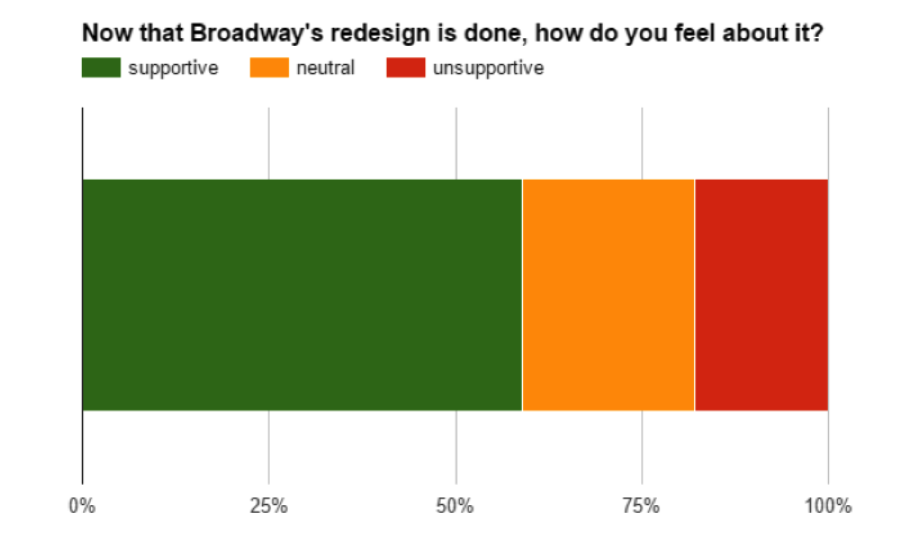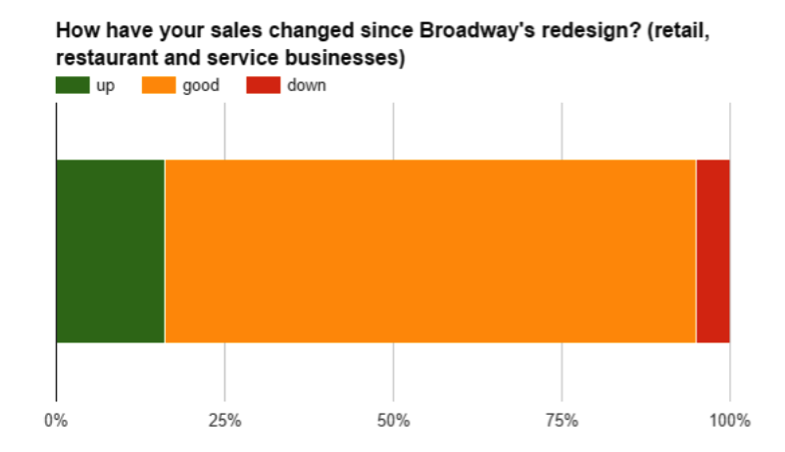June 4, 2018
Strong Towns by Rachel Quednau
Kenmore Boulevard in Akron, Ohio is in the process of a street redesign which may involve the loss of some on-street parking spots in order to create protected bike lanes. This sort of transition is happening all over the country as more and more cities recognize the transformative impact that bike lanes can have on their city, as well as the prosperity that impact can create.
But still, there’s no doubt that installing bike lanes can feel like a big change. When you’ve owned a business on the same street for years and suddenly the view outside your window looks different, it makes sense that you might wonder whether the outcome will be positive or negative for your customers and your bottom line.
Today I want to share several reasons why business owners can rest easy about the addition of bike lanes—and, even better, celebrate their new infrastructure. In city after city, business owners are seeing more customers come through their doors and more revenue flowing into cash registers when streets are redesigned to be more walk- and bike-friendly.
Customers Will Continue to have Plenty of Parking Options
Concerns about parking are absolutely valid. Business owners who are used to having lots of open parking spaces right outside their door may be concerned when their street is redesigned. It’s natural to feel worried about the impact of that sort of change. But let’s zoom out just a tiny bit to get a fuller picture.

Akron’s Kenmore Blvd, with available street parking marked in orange and off-street parking marked in pink. (Created by Rachel Quednau with Google Maps image)
In the above aerial image of Akron’s Kenmore Blvd (the main street running east/west in the illustration) from approximately 16th to 13th Street, I’ve highlighted all available street parking in orange that will not be removed as a result of the street redesign. As you can see, there are a ton of parking spaces no more than 1-2 blocks (about 150-300 feet) away from each Kenmore Blvd business that will be easily accessible for customers after the redesign.
Compare this to a mall or grocery store parking lot, which is typically much larger and which often requires a customer to walk farther than 150 or 300 feet. These are very standard distances that people have no problem traveling on foot on a daily basis.
Yes, customers may need to slightly adjust their habit of parking directly outside a business’s front door. But we’re talking about a difference of a 30- or 60-second walk when we compare a front door parking spot with parking spot just down the street. What’s more, during that walk customers will pass by other businesses on Kenmore and see them up close instead of viewing them through a fast-moving car window. This benefits everyone.
Just to add some additional perspective, in the above image I’ve also highlighted all of the surface parking lots in the vicinity of this segment of Kenmore Blvd in pink. While most of these are private, they show that most customers of the adjacent businesses will be parking in those lots, leaving even morespace on the street for customers of the businesses that don’t own private lots.
As I examined these streets on Google Maps, I saw hardly any cars parked on them — perhaps one or two at most. Combining this assessment with data from the City of Akron, it’s safe to say there will be dozens, if not hundreds, of vacant spots ready to be occupied by customers of Kenmore Blvd businesses at all times, even after the bike lanes are installed.
A Transition that Benefits Everyone
Business owners can take some very simple steps that will make the transition to a new street design go smoothly, and they can also take heart that this transition is a positive change for Kenmore Blvd and other places like it.
One way to make extra sure that customers aren’t deterred by a slight change in parking is to create signage outside that directs people to nearby side streets and tells customers that these shops are still open for business, even if the street looks slightly different than they’re used to. Posting on a business’s website and/or Facebook page to let people know where they can park can be helpful as well.

Protected bike lanes create an environment where pedestrians feel safer walking and cars still have easy access to shops along the street. (Source: Green Lane Project)
The overarching goal of this street redesign is to make Kenmore Blvd a more attractive, welcoming and safe place for everyone, creating a better atmosphere for business to flourish.
Picture the busiest, most successful shopping districts in America. Think Michigan Avenue in downtown Chicago or Pike Place Market in Seattle. Are these areas filled with parking lots and parking spaces? No. They’re filled with people walking around from store to store.
Akron, Ohio is, of course, a very different place from Chicago or Seattle, but that doesn’t mean the same basic concepts won’t apply. When you make an area appealing for people on foot or on a bike — when you slow down the pace of life in that neighborhood just a little — suddenly visitors are lingering longer and stopping in more stores. Suddenly residents are walking or biking over on a regular basis to see what’s new.
This street redesign aims to create more access to Kenmore, not less. As I’ve shown in the illustration above, the decreases in automobile parking will be minimal — but the increases in bike access and walk-friendliness will be huge, and those will bring lots of new customers to the area. In other cities around the country, some business owners have chosen to offer small discounts or incentives for people who bike to their shop, which capitalizes on the change in street design to invite new customers to patronize a store. Other business owners may choose to install a bike rack outside to further encourage people to stop and stay a while.
Extra steps like these are by no means necessary to reap the benefits of a bicycle-friendly street redesign, but they’re small things a business can undertake to enhance the experience even further and supercharge profit potential in the process.
Businesses Thrive in Other Cities with Protected Bike Lanes
But if this still isn’t enough to convince you, I’ve compiled research from a variety of cities on the impacts of removing parking for the sake of road diets and bike lanes. These perspectives from real business owners across the country prove that bike lanes often have a positive effect on sales and customer traffic.


In New York City, the addition of a protected bike lane on two major streets led to “a 50 percent increase in sales receipts.”
In San Francisco, after a bike lane was added on Valencia Street “two-thirds of the merchants said bike lanes had been good for business.”
In Seattle, the creation of a new bike lane, which eliminated 12 on-street parking spaces resulted in a serious increase in retail sales along the street.
When a new protected bike lane was installed on Broadway in Salt Lake City, sales on the street rose 8.8%, in spite of the fact that the bike lanes decreased on-street parking by 30%. Surveys of business owners along the street showed that a majority of them felt that the change was positive, and most of the remaining business owners felt neutral about it (see charts on the side, courtesy of People for Bikes).
In 2013, the city of Vancouver installed protected bike lanes on a key street, which involved removing 20 parking spaces. For business owners along this corridor, their initial fears about losing sales did indeed come true. But that was only a short-term result. Soon after the bike lanes were installed, one local restaurant owner happily reported that business was better than ever and stated, “We definitely have benefited from the increased usage of the bike lane.” With a slew of bike riders now streaming by, he was able to reach a range of new customers.
I’ll note that many of the examples I’m sharing here are from large cities, but that’s not because the results won’t apply in smaller communities. It’s just because those are the places where data has been collected, and where bike lanes have grown more prevalent. I hope we can add more examples from smaller cities like Akron to the list very soon.
As an article on the transportation website, Streetsblog, explains, “Streets that accommodate all users — including cyclists, pedestrians, and transit riders — mean less traffic congestion and better quality of life. Not surprisingly, then, they are also linked to higher commercial property values and lower vacancy rates.”
—–
When faced with the prospect of losing some on-street parking outside a local business, it completely makes sense for business owners to be concerned about the impact on their customer base. But the on-the-ground evidence as well as nationwide data paints a very different picture.
Rest assured that, if bike lanes are coming to your street and some parking spaces are disappearing in the process, local businesses shouldn’t see losses in profit. In fact, they’re likely to see gains.
(Top photo by Adam Coppola taken under contract for PeopleForBikes)
RelatedHow a Local Bookstore Can Make Your Town Richer—In More Than One Way
Can a humble corner bookstore make your city wealthier and more resilient? These small businesses have surprising staying power—and in many ways are an indicator species of a strong neighborhood.Jan 8, 2019 Kea WilsonThere’s a Missing Middle for Commercial Spaces, Too
Is a desire for local character your jam? If so, fight for missing-middle commercial space in your neighborhood. Fight for the corner bar and the corner store. We need an approach that is much more flexible, more true to what humans want from cities, and messier.Nov 6, 2018 Kevin KlinkenbergWhat’s up with all those empty commercial storefronts in new mixed-use developments?
Why all these new storefronts are sitting vacant.Jun 6, 2018 Rachel Quednau
Rachel Quednau served as Content Managerfor Strong Towns from 2015-2018 and is currently in a Master of Theological Studies program at Harvard Divinity School. Previously, she worked for several organizations fighting to end homelessness at the federal and local levels. Rachel is a Midwesterner who draws from her experiences living in Milwaukee, WI, New York City, Washington, DC, Walla Walla, WA and Minneapolis, MN to help her build better places wherever she is. She has a B.A. in Religion from Whitman College and lives with her husband, Jack, in Cambridge, MA. One of her favorite ways to get to know a new city is by going for a run in it. You can find her musings on Twitter @rquednau.
This essay is part of an ongoing engagement with Akron, Ohio, supported by the Knight Foundation. Learn more about it here.
10 Comments 0 Likes SharePosted inQuednau, Parking, Akron, Bikeabilityandtagged withprotected bike lane, page highlight, bike lanes
